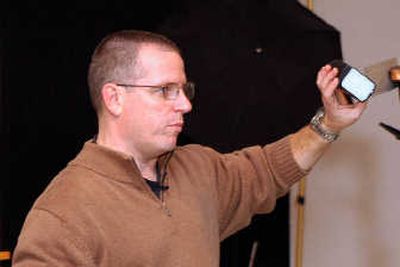Sharing photo lighting tips through a blog

COLUMBIA, Md. – All David Hobby wanted to do was pass along photo lighting tips to a friend.
He jotted down some ideas and posted a blog – Strobist – to show how any beginning photographer could get beyond ordinary shots by using $300 flashes, just like pros.
Then the world found out about him.
Hobby now has 200,000 mostly amateur photographers as devoted readers. His site attracts 1.6 million page views a month.
“This little blog has become as big, if not bigger, than many popular photo magazines,” says Hobby, 43. “The only difference is, it’s all run by a one-person staff.”
Hobby’s experience shows how people with a passion can find a new means of employment on the Internet. The good news: Work from home or wherever and make your own hours. The bad news: The monster always has to be fed. And there is no guarantee of success.
Hobby is eight months into his experiment to see if he can balance life and work as a blogger. He’s taking a one-year leave of absence from his job as a staff photographer at The Sun in Baltimore.
So far, he’s making more money than at The Sun. He won’t say how much, only that revenue is more than six figures, all from photographic-supply advertisers. His overhead is zero.
Strobist is hosted free by Google, which provides blogging software. Readers post pictures and hold discussions on a Strobist area of Yahoo’s Flickr photo Web site. While Hobby works at home most evenings, his days are spent at a library. Hobby uses the library’s free Wi-Fi to cruise photo sites and keep up with the constant comments from readers.
“David has demystified flash photography,” says noted photographer Joe McNally, who has shot for National Geographic and Sports Illustrated. “Strobes are integral to photography, but there’s a great deal of mystery and fear among amateur photographers. David’s made it accessible and given solutions to people that aren’t beyond the reach of your average Joe.”
Readers range from a Utah woman looking to improve her family pictures to geeky Google engineers who became such major Strobists they flew Hobby to Google headquarters to teach lighting tips in person.
His tips are based on using light just as great artists and photographers do, to show shape and dimension. His advice is geared toward the digital photographer who advances to more expensive and versatile single-lens reflex cameras, such as Canon’s EOS Rebel and Nikon’s D60.
Hobby recommends buying at least one accessory flash and using it off the camera – on a light stand, for instance – for better results. He shows on the site how this can be done.
The main point of Strobist is that shutterbugs don’t need to lug heavy equipment to get magazine-quality images. Small flashes, when multiplied, can produce stellar results. The beauty of the digital age is that you see results instantly and can experiment until you get it right.